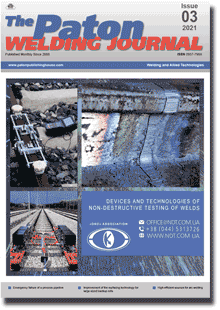| 2021 №03 (01) |
DOI of Article 10.37434/tpwj2021.03.02 |
2021 №03 (03) |

The Paton Welding Journal, 2021, #3, 9-15 pages
Mathematical modeling of residual stresses in WWER-1000 elements after heat treatment
O.V. Makhnenko1, S.M. Kandala1, N.R. Basystyuk1 and M.V. Cherkashin2
1E.O. Paton Electric Welding Institute of the NASU. 11 Kazymyr Malevych Str., 03150, Kyiv, Ukraine. E-mail: office@paton.kiev.ua
2«UKRTNIITMASh» Company, 7a Vasylenka Str., 03124, Kyiv, Ukraine. E-mail: ukrcniitmash@ukr.net
Abstract
Determination of residual life and extension of safe operating life of WWER-1000 internals for a term of up to 60 years beyond the design period is an important scientific and engineering objective for nuclear power industry of Ukraine. During long-term operation the reactor internal elements: reflection shield and cavity are exposed to intensive impact of damaging radiation dose that causes the processes of radiation embrittlement, swelling and creep in the material (08Kh18N10T austenitic steel). Technological residual stresses after welding and subsequent heat treatment should be taken into account at calculation-based substantiation of the safe operating life of reactor internal elements. In the work, mathematical modeling was used to derive residual stress distributions in the volume of the reflection shield and internal cavity after electroslag welding and their redistribution fields after the technological process of postweld heat treatment by the austenitizing mode. It is determined that the residual welding stresses are largely relaxed during austenitizing. In the reflection shield, however, which is of complex geometry with variable wall thickness and cooling channels, high residual stresses develop, due to occurrence of a significant temperature gradient at cooling during austenitizing. These stresses should be taken into account at determination of the residual life of WWER-1000 reactor internals. 8 Ref., 8 Figures.
Keywords: WWER-1000, reactor internals, reflection shield, internal cavity, electroslag welding, heat treatment, austenitizing, residual stresses
Received 01.03.2021
References
1. (1989) PNAE G-7-009-89. Equipment and pipelines of nuclear power installations. Welding and overlaying, general provisions. Moscow, ENERGOATOMIZDAT.2. (1985) Rakhmilevich Z.Z., Radzin I.M., Faramazov S.A. Reference book of mechanic of chemical and petrochemical production. Moscow.
3. (2016) Makhnenko O.V., Mirzov I.V., and Porokhonko V.B. Modeling of residual stresses, radiation swelling and stressed state of in-service WWER-1000 reactor baffle. The Paton Welding J., 4, 32-38. https://doi.org/10.15407/tpwj2016.04.03
4. (1976) Makhnenko V.I. Computational methods of investigation of welded stress and strain kinetics. Kiev, Naukova Dumka.
5. (2004) STP 26.260.484-2004 Heat treatment of corrosion-resistant steels and iron-nickel-based alloys in chemical engineering. OJSC «NIIKHIMMASH».
6. (1966) Rabotnov Yu.N. Creep of structural elements. Moscow, GIFML.
7. (2006) Margolin, B.Z., Gulenko, A.G., Kursevich, I.P., Buchatskii, A.A. Modeling for fracture in materials under longterm static creep loading and neutron irradiation. Part 2. Prediction of creep rupture strength for austenitic materials. Strength of Materials, 38(5), 449-457. https://doi.org/10.1007/s11223-006-0064-z
8. (1953) Nemchinskiy A.L. Thermal calculations of heat treatment. Leningrad, Sudpromgiz.
